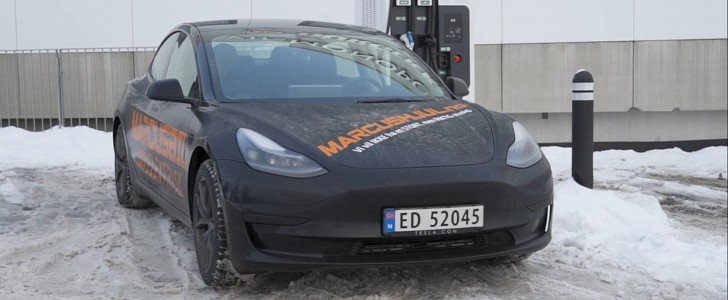Following a successful introduction in China, Tesla has started to switch all Standard Range vehicles to using Lithium Iron Phosphate (LFP) batteries. These are heavier and slightly less powerful, among other things, but they seem to shine in colder climates.
Tesla began using the new chemistry a year ago for the base models built in China but later decided to extend the use of LFPs to all its base models sold throughout the world. Having a lower energy density, LFP batteries are only good for the base Standard Range models, at least for now. This goes well with their lower price, although Tesla inexplicably put a premium on their base model after switching to the new battery.
Of course, being new to the western markets, the LFP batteries are little known and a lot of people want to know how they hold both as range and as durability in the long run. The good news is coming from the coldest territories of Norway in Europe and it says the new battery is even better in sub-zero temperatures than the older NCA (lithium nickel-cobalt-aluminum oxide) battery it replaced.
YouTuber Kris Rifa wanted to find out just how good the new batteries are in the cold. Therefore he conducted a range test on the highway in Norway at temperatures ranging between -4°C and -7°C (25°F and 19°F). For those who keep count, regular Li-Ion batteries start to lose their efficiency in the cold, and not even LFPs have a good record in this regard.
But, alas, a Tesla Model 3 RWD featuring the new battery showed impressive results in the range test. The car started with a 99% state of charge and was driven over 237.8 km (147.7 miles) at an average speed of 112.7 kph (70 mph)/ It still had 19% battery at the end of the journey.
While this doesn’t sound impressive, it should be noted that the car has a 60 kWh battery, and this means a consumption rate of 18.8 kWh/100 km (3.30 miles/kWh). It’s the lowest yet compared to 12 other EVs Kris tested along the same route. This includes the Tesla Model 3 with an NCA battery, which managed 20.3kWh/100km (3.06 mi/kWh).
So there you have it, LFP batteries are even better than the previous NCA cells, at least when powering the Tesla Model 3. This is especially true when it comes to driving in the cold. Did we mention that LFP batteries can be charged to 100% without risking degradation? That is another bonus for longer trips, so it looks like the new chemistry is already a winner.
Of course, being new to the western markets, the LFP batteries are little known and a lot of people want to know how they hold both as range and as durability in the long run. The good news is coming from the coldest territories of Norway in Europe and it says the new battery is even better in sub-zero temperatures than the older NCA (lithium nickel-cobalt-aluminum oxide) battery it replaced.
YouTuber Kris Rifa wanted to find out just how good the new batteries are in the cold. Therefore he conducted a range test on the highway in Norway at temperatures ranging between -4°C and -7°C (25°F and 19°F). For those who keep count, regular Li-Ion batteries start to lose their efficiency in the cold, and not even LFPs have a good record in this regard.
But, alas, a Tesla Model 3 RWD featuring the new battery showed impressive results in the range test. The car started with a 99% state of charge and was driven over 237.8 km (147.7 miles) at an average speed of 112.7 kph (70 mph)/ It still had 19% battery at the end of the journey.
While this doesn’t sound impressive, it should be noted that the car has a 60 kWh battery, and this means a consumption rate of 18.8 kWh/100 km (3.30 miles/kWh). It’s the lowest yet compared to 12 other EVs Kris tested along the same route. This includes the Tesla Model 3 with an NCA battery, which managed 20.3kWh/100km (3.06 mi/kWh).
So there you have it, LFP batteries are even better than the previous NCA cells, at least when powering the Tesla Model 3. This is especially true when it comes to driving in the cold. Did we mention that LFP batteries can be charged to 100% without risking degradation? That is another bonus for longer trips, so it looks like the new chemistry is already a winner.








